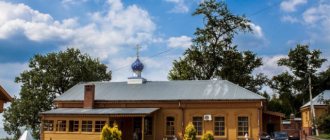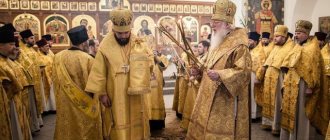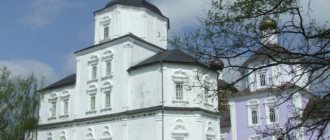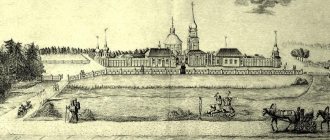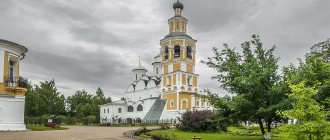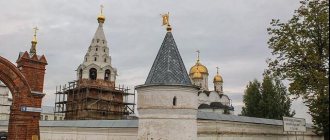Mir
Russia Voronezh Region Belogorsky Resurrection Monastery Map loading in progress...
{"format":"leaflet","minzoom":false,"maxzoom":false,"limit":50,"offset":0,"link":"all","sort":[""], "order":[],"headers":"show","mainlabel":"","intro":"","outro":"","searchlabel":"\u2026 \u0441\u043b\u0435\ u0434\u0443\u044e\u0449\u0438\u0435 \u0440\u0435\u0437\u0443\u043b\u044c\u0442\u0430\u0442\u044b","default":"","import-annotation":false,"width ":"auto","height":"350px","centre":{"text":"","title":"""link":"""lat":50.47145230000000282188921119086444377899169921875,"lon": 40.033517299999999750070855952799320220947265625,"icon":""},"title":"","label":"","icon":"","lines":[],"polygons":[],"circles":[ ],"rectangles":[],"copycoords":false,"static":false,"zoom":8,"defzoom":14,"layers":["OpenStreetMap"],"image layers":[] ,"overlays":[],"resizable":false,"fullscreen":true,"scrollwheelzoom":true,"cluster":false,"clustermaxzoom":9,"clusterzoomonclick":true,"clustermaxradius":80, "clusterspiderfy":true,"geojson":"","clicktarget":"","showtitle":true,"hidenamespace":false,"template":"","userparam":"","activeicon": "","pagelabel":false,"ajaxcoordproperty":"","ajaxquery":"","locations":[{"text":"\u003Cb\u003E\u003Ca href=\"/palomnik/%D0% 91%D0%B5%D0%BB%D0%BE%D0%B3%D0%BE%D1%80%D1%81%D0%BA%D0%B8%D0%B9_%D0%92%D0%BE% D1%81%D0%BA%D1%80%D0%B5%D1%81%D0%B5%D0%BD%D1%81%D0%BA%D0%B8%D0%B9_%D0%BC%D0% BE%D0%BD%D0%B0%D1%81%D1%82%D1%8B%D1%80%D1%8C\" title=\"\u0411\u0435\u043b\u043e\u0433\u043e\u0440\ u0441\u043a\u0438\u0439 \u0412\u043e\u0441\u043a\u0440\u0435\u0441\u0435\u043d\u0441\u043a\u0438\u0439 \u043c\u043e\u043d\u0 430\u0441\u0442\u044b\u0440\ u044c\"\u003E\u0411\u0435\u043b\u043e\u0433\u043e\u0440\u0441\u043a\u0438\u0439 \u0412\u043e\u0441\u043a\u0440\u0435\u0441\u 0435\u043d\u0441\u043a\ u0438\u0439 \u043c\u043e\u043d\u0430\u0441\u0442\u044b\u0440\u044c\u003C/a\u003E\u003C/b\u003E\u003Chr /\u003E\u003Ca href=\"/palomnik/ %D0% A1%D0%B2%D0%BE%D0%B9%D1%81%D1%82%D0%B2%D0%BE:%D0%90%D0%BD%D0%BD%D0%BE%D1%82 %D0%B0%D1%86%D0%B8%D1%8F\" title=\"\u0421\u0432\u043e\u0439\u0441\u0442\u0432\u043e:\u0410\u043d\u043d\u043e\u0442\ u0430\u0446\u0438\u044f\»\u003E\u0410\u043d\u043d\u043e\u0442\u0430\u0446\u0438\u044f\u003C/a\u003E: \u043f\u0435\u0449\u043 5\u0440\u043d\u044b \u0439 \u043c\u0443\u0436\u0441\u043a\u043e\u0439 \u043c\u043e\u043d\u0430\u0441\u0442\u044b\u0440\u044c. \u041d\u0430\u0445\u043e\u0434\u0438\u0442\u0441\u044f \u0432 4 \u043a\u0438\u043b\u043e\u043c\u0435\u0442\u0440\u0430\u044 5 \u043e\u0442 \u0441\u0435\ u043b\u0430 \u0411\u0435\u043b\u043e\u0433\u043e\u0440\u044c\u0435 \u041f\u043e\u0434\u0433\u043e\u0440\u0435\u043d\u0441\u0 43a\u043e\u0433\u043e\u0440\ u0430\u0439\u043e\u043d\u0430 \u0412\u043e\u0440\u043e\u043d\u0435\u0436\u0441\u043a\u043e\u0439 \u043e\u0431\u043b\u0430\u0 441\u0442\u0438.","title ":"\u0411\u0435\u043b\u043e\u0433\u043e\u0440\u0441\u043a\u0438\u0439 \u0412\u043e\u0441\u043a\u0440\u0435\u0441\u0435\u043 d\u0441\u043a\u0438\ u0439 \u043c\u043e\u043d\u0430\u0441\u0442\u044b\u0440\u044c","link":"","lat":50.47145230000000282188921119086444377899169921875,"lon ":40.033517299999999750070855952799320220947265625,"icon":""}]" imageLayers":[]}
50.470683; 40.038406
Russia, Voronezh region, Podgorensky district, specially protected natural area Belogorye tract
Voronezh region
Russia
Telephone:
(47394) 5-23-21 (monastery in the village of Kirpichi), 5-26-00 (Trinity Church in the village of Belogorye)
Belogorsky Resurrection Monastery
- cave monastery. It is located 4 kilometers from the village of Belogorye, Podgorensky district, Voronezh region.
History[edit]
Foundation[edit]
The monastery was founded in 1796 by Maria Sherstyukova, the first abbess of the monastery. The daughter of the Ukrainian Cossack Konstantin Bosogo, she received a blessing for monastic labors in Belogorye, while on a pilgrimage in the Kiev-Pechersk Lavra. Maria’s work on the construction of caves in Belogorye initially provoked opposition from the local population and authorities.
At the beginning of the 19th century, a decree of Alexander I followed on a thorough investigation of Mary’s case. In the event of a positive outcome of the case, it was intended to provide Maria with the necessary assistance. A special commission comprehensively studied the case and rendered a verdict on the sincerity of the spiritual intentions of the cave digger, after which the persecution was stopped, and 2,500 rubles were allocated from the state treasury for the construction of a cave temple. As a sign of gratitude for the help provided, Mary dedicated the temple to St. Alexander Nevsky - the saint in whose honor Emperor Alexander I was baptized. The consecration of the temple took place on August 30, 1819, it was carried out by Archpriest of the Kiev-Pechersk Lavra Afinogenes Pechersky.
During Maria's lifetime, the length of the caves reached more than 299 arshins (about 212 meters). Among those who helped dig the caves was Elder John Alekseevich Tishchenko, a companion of Mary.
The founder of the monastery died on June 22, 1822 at the age of eighty-two. Mary and Elder John, who briefly survived her, were buried at the top of a cave mountain in specially constructed crypts. That part of the caves that was dug during Mary’s lifetime is called old caves. Digging of caves continued after her death: these caves began to be called new.
From 1819 to 1856, the Belogorsk community sent more than 20 thousand rubles to the Voronezh Trust for the Poor.
Gradually, the Belogorsk community built several churches, a stone bell tower and buildings for ascetics.
Second half of the 19th - early 20th centuries[edit]
In 1866, through the efforts of Voronezh Archbishop Seraphim (Aretinsky), the community of cave diggers received the official status of a monastery and was assigned to the Holy Dormition Divnogorsk Monastery as a monastery.
By the end of the 19th century, the number of brethren was about twenty, and the workers - about seventy people. The last abbot of the Resurrection Belogorsk Monastery was Abbot Polycarp, who completed the construction of the majestic Resurrection Church, made in the Byzantine style by the provincial architect Afanasyev and painted by the famous master Shchukin in 1916.
The length of the caves by that time significantly exceeded two kilometers. In the same year, through the efforts of the brethren and all the nearby living admirers of the monastery, a unique well was dug in the chalk mountain with a depth of more than eighty meters and a diameter of more than three. For five years work continued on the top of the mountain, and finally clean water under pressure crowned the almost hopeless undertaking with success.
Dissolution of the monastery[edit]
After the October Revolution, the Trinity and Transfiguration churches were destroyed, the brethren were dispersed, partially exiled, the monastery was closed, the buildings were dismantled for building materials, church utensils and icons were confiscated, the relics of Mary and John were desecrated and disappeared without a trace. A grain farm was built on the site of the monastery.
The caves, destroyed by time, the hard times of war, as well as the idle, curious travelers who entered them, who, leaving inscriptions on the walls, often did not think about what they were doing, were partially destroyed, blocked by rubble and desecrated. Currently (2014) the length of the surviving caves is 985 meters.
Who is Maria Sherstyukova
As mentioned earlier, Maria Sherstyukova laid the foundation for the foundation of the Belogorsk caves. She was different from her brothers and sisters not only in appearance, but also in spirit. Maria dreamed of becoming a nun since childhood. But the parents were against it. At the age of 25, she married a military man who constantly drank and partyed. Leaving Mary with three children, her husband died. The woman was widowed early and plunged headlong into a wild life. She drank endlessly and indulged in debauchery, sometimes earning her living by witchcraft. Relatives, neighbors, fellow villagers - everyone reviled Maria. She lived in extreme poverty. But one amazing incident completely changed her life. At the age of 55, she visited the Kiev Pechersk Lavra. There she was given the blessing to go to her homeland and find a quiet place on the mountain and dig a cave of repentance there. When Maria arrived in her native village, she immediately got to work. She met with extreme indignation from local residents. Persecution haunted Mary until the authorities intervened in the construction of the temple, providing the woman with financial assistance.
For 30 fruitful years, Maria was engaged in ascetic activity. Over time, a whole team of assistants and followers was formed.
Current state[edit]
In 2003, the first effort was made to revive the monastery. Through the efforts of local residents, historians, local historians, teachers, children, believers and caring people, rubble, entrances, and sites were cleared.
On September 12, 2004, on the patronal feast of the transfer of the relics of the holy noble prince Alexander Nevsky, the first Divine Liturgy was celebrated. Following the planning of restoration activities, active clearing of the walls began. Since 2005, preliminary restoration of the temple and the premises of the cave system has been carried out.
In October 2005, a particle of the relics of the holy noble prince Alexander Nevsky was transferred to the cave temple, and in 2006, services were regularly held in the temple.
A small part of the brethren now lived on the Kirpichi farmstead, between Belogorye and the monastery.
Officially revived on October 2, 2013 by the decision of the Holy Synod of the Russian Orthodox Church.
Revival of the monastery
All ground structures, buildings and temples were completely destroyed. The brethren were faced with a seemingly impossible task of restoring everything. First, it was necessary to clear and restore the Belogorye caves themselves, which carried within them the spirit of brave service of the common people. After all, these people so ardently sought to ensure that the will of the Lord was fulfilled and, in addition to everyday prayer, people could serve God in these unique cave temples, chapels and cells, which are filled with purity and reverence, so necessary for a full spiritual life. Their efforts were not in vain. Indeed, to this day, everyone who visits Belogorye (Voronezh region), the monastery, will be filled with incredible spiritual strength. Belogorsk shrines are an indestructible monument to the national spirit.
July 29 is a special day for the monastery. Every year on this day a large religious procession takes place. All pilgrims travel 40 km along the banks of the Don. The first overnight stay is in the village of Verkhniy Karabut, the second in Kolodezhny. On July 31, all participants gather in Kostomarovo in order to celebrate the discovery of the relics of St. Seraphim of Sarov the next day (August 1).
The monastery was officially opened quite recently, in 2013.
If there is such an opportunity, you should definitely visit Belogorye (Voronezh region). The monastery is open almost 24 hours a day.
Shrines[edit]
- Icon of the Blessed Virgin Mary “Mary Find Grace from God”
- Reliquary with a particle of the relics of the Blessed Virgin Mary. book Alexander Nevsky - transferred to the cave temple in October 2005
- Ark with particles of the relics of the Great Martyr. Panteleimon, mchch. Monastery of Gerasim of Jordan, martyr. Bethlehem Infants, St. Mitrofan of Voronezh, St. Tikhon of Zadonsk, St. Demetrius of Rostov, St. Pitirim of Tambov, St. Meletius of Ryazan, martyr. Gabriel of Athos, St. Ambrose of Optina, St. Nectarius of Optina, St. Anatoly Optinsky Jr., St. Job of Pochaevsky, St. Amphilochius of Pochaevsky, St. Euphrosyne of Polotsk, St. Irinarch of Solovetsky, St. Hilarion Troekurovsky, St. Theodore Zverinetsky, St. Kiev-Pechersk: Isaiah the wonderworker, John the long-suffering, Mercury, Agapit the gratuitous doctor, Paul the obedient, Gregory the wonderworker, Nikola Svyatoshi, Nikon, Savva the wonderworker, St. Kuksha of Odessa, St. Theophilus of Kyiv, St. Jonah of Kyiv, St. Shio Mgvimsky, St. Theodore of Sanaksar, martyr. Alexander of Sanaksar, St. right warrior Feodor Ushakov
Hotels
Within a radius of 10 km from the monastery, opportunities for comfortable overnight stays are available only in Pavlovsk.
- Hostel "Chernozemye" is a budget holiday option. The hotel is located 1 km from the M-4 highway and 1.5 km from the city center - st. Stroitelnaya, 15. The rooms are clean and warm in any weather. Special services: parking, pet permission. Double room – from 1500 rub.
- The Onyx mini-hotel is famous among motor tourists for its good price-quality ratio, located 500 m from the highway, at the address: Transportnaya, 2. There is a parking lot, a shared kitchen with a kettle-fridge, comfortable beds, and a grocery store is within walking distance.
- Hotel "Don" is located away from the highway, located on the street. Gottwald 4, near the center. The hotel tries to make guests' stay as comfortable as possible. There is a 24-hour cafe, the quality of food there, according to reviews, is not inferior to homemade food. The price includes breakfast - it is provided as a packed lunch if guests leave early in the morning. Not far away is the Central Beach, the pier from which boat excursions to the Belogorsk Monastery depart.
Temples and caves[edit]
The caves of the monastery, begun by the efforts of the ascetic Mary, reached more than 299 arshins (about 212 meters) in length during her lifetime. By 1916, the length of the caves significantly exceeded two kilometers. During the Soviet years, time, wartime hardships, and thousands of travelers severely damaged the caves. By the 1990s, they were partially destroyed, blocked by rubble and desecrated. By the 2000s, the length was about 800 meters.
Alexander Nevsky Church[edit]
The first church of the future monastery - dedicated to the blessed Grand Duke Alexander Nevsky - was consecrated on August 30, 1819 by Pavlovsk Archpriest Afinogen of Pechersk. After almost a century of desolation of the caves, in the 2000s the temple became the first revived church of the restored monastery.
Single-limit temple. The patronal feast day is celebrated on the day of the transfer of the relics of the blessed prince - August 30 according to the church calendar.
Resurrection Cathedral[edit]
The largest church of the monastery - in honor of the Resurrection of Christ - was founded under the leadership of Hieromonk Peter and completed under Abbot Polycarp. Effective in 1882. It was built in the Byzantine style by the provincial architect Afanasyev. In 1916 it was painted by the famous master Shchukin and consecrated. In 1931, by order of the Pavlovsk District Executive Committee, it was blown up [5].
Church of the Ascension[edit]
The above-ground church in honor of the Ascension of the Lord operated in 1882, but was destroyed after the revolution.
Abbots of the monastery
In 1882, the monastery was transformed into an independent Belogorsky Resurrection Monastery. The rector became Hieromonk Peter, who had previously served at the Mitrofanovsky Monastery in Voronezh, and in 1875 was transferred to serve in the monastery. He did a lot for the monastery. A school was set up under him - a shelter for boys. Until his death, Peter himself taught the children, since he himself was a highly educated person. Father Peter was an incredibly energetic person. He was distinguished by his severity, but at the same time by his sincerity and caring nature. In 1896, he began construction of a new cathedral, but never saw its completion. In 1916 the cathedral was consecrated. He stood high above the expanses of the Don. Everyone who wanted to get into the monastery immediately noticed him.
Excursions around the Voronezh region will definitely lead to the Resurrection Monastery, the last abbot of which was Abbot Polycarp. He served in the monastery until its closure in 1922.
How to get there[edit]
Address:
Russia, 396576, Voronezh region, Podgorensky district, village. Belogorye, x. Bricks
Tel:
(47394) 5-23-21 (monastery in the village of Kirpichi), 5-26-00 (Trinity Church in the village of Belogorye)
Official site:
https://belmon.ru
Travel by car:
From Voronezh - along the M4 highway, about 15 km before reaching Pavlovsk, turn right at the sign Rossosh, Belogorye, Babka - after the turn to Belogorye 7 km. In the village of Belogorye, go to the Trinity Church, where, depending on the time of year, they will tell you which of the roads to the monastery will be the best. From Belogorye to the village of Kirpichi, which is located downstream of the Don River (depending on the route) is from 3 to 10 km.
From Ostrogozhsk, Rossoshi (along the Voronezh-Lugansk highway) - to the village of Podgorensky and further, drive through the entire village to the cement plant, towards Pavlovsk, not reaching 30 km. In the village of Belogorye, go to the Trinity Church.
Travel by passenger transport:
On any bus to Pavlovsk, here you change to buses in the direction of Rossosh, Olkhovatka, Podgorensky to the village. Belogorye. From there it is a 3 km walk to the Kirpichi village.
Travel by train or train:
To the Podgorensky station, change to a bus to Pavlovsk, and before reaching 30 km, get off at Belogorye.
Travel by water:
from Pavlovsk by passenger boat (by reservation), pilgrim groups (up to 50 people) are delivered along the Don River directly to the monastery.
Belogorsky Resurrection Monastery. Curious facts
- Some time before the monastery was closed in 1922, a criminal case was opened. During the investigation, the investigator, who constantly mocked the remains of the saints, fell ill with a serious skin disease and died. Many were struck by the mysterious illness of investigator Boris Usatov. He was extremely disdainful of this holy place, especially the relics of Mary (the founder of the monastery). Some parts of his body began to become covered with scales. Even the most experienced doctors could not cure the disease, and after some time the investigator died a painful death.
- During the war, the monastery was completely destroyed, but its caves served as a safe haven for local residents. Partisan groups also gathered there.
- The caves are of particular importance for the village of Belogorye. The monastery is located on them. The Belogorye caves are considered the largest monastic dungeon in Russia, created artificially. Today most of the caves are abandoned. Their length was reduced from 2 km to 985 meters.
